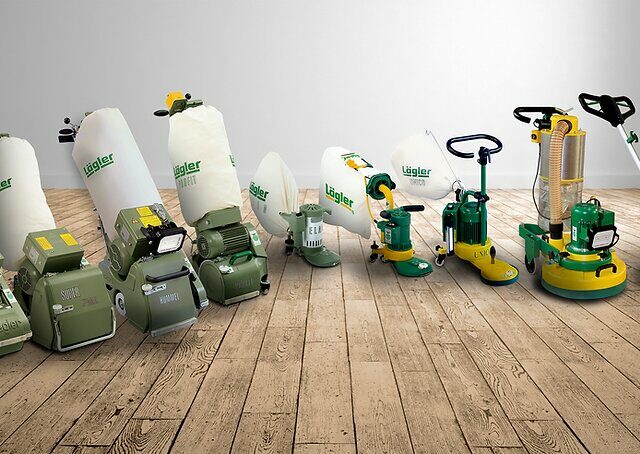London:
Nationwide:
Post-Sanding Care: Should You Reoil Your Kitchen Worktop After Sanding?
Posted on January 11, 2024
Kitchen Worktop Oiling
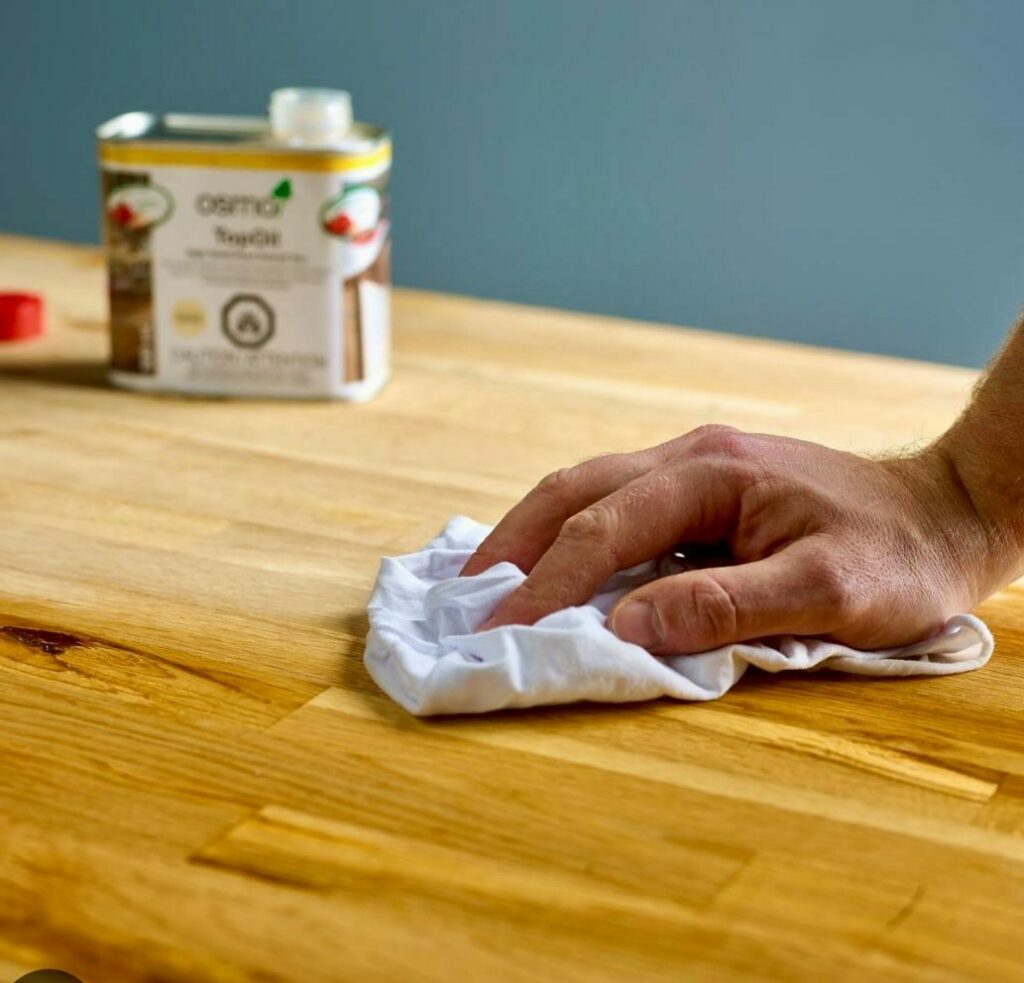
How to Take Care of Your Kitchen Worktop After Sanding: Should You Recoat It?
Your kitchen worktop is a focal point in your home, serving as both a functional workspace and a design element that can significantly impact the aesthetics of your kitchen. Over time, however, the wear and tear of daily life can take a toll on the appearance and durability of your worktop. This is where kitchen worktop sanding comes into play, offering a valuable solution to rejuvenate and restore your kitchen worktop’s beauty and resilience. In this blog post, we’ll explore the essential aspects of post-sanding care, focusing on a crucial question: should you reoil your kitchen worktop after sanding?
Kitchen Worktop Sanding is a critical step in the maintenance and upkeep of your kitchen worktop, but it’s not just about cosmetic improvements. It plays a pivotal role in enhancing the longevity of your worktop, keeping it in top-notch condition for years to come. In this article, we’ll delve into the intricacies of sanding, discussing various methods, when and why it’s necessary, and how it contributes to the overall health of your worktop.
We’ll also address the post-sanding care aspect, which often involves the application of oil. The decision to reoil your kitchen worktop is a topic of debate among homeowners and DIY enthusiasts. We’ll weigh the pros and cons, providing you with the knowledge needed to make an informed choice. Whether you’re a seasoned DIYer or a first-time worktop owner, understanding the importance of post-sanding care and the role of oil will empower you to make the right decision for your kitchen’s heart and soul.
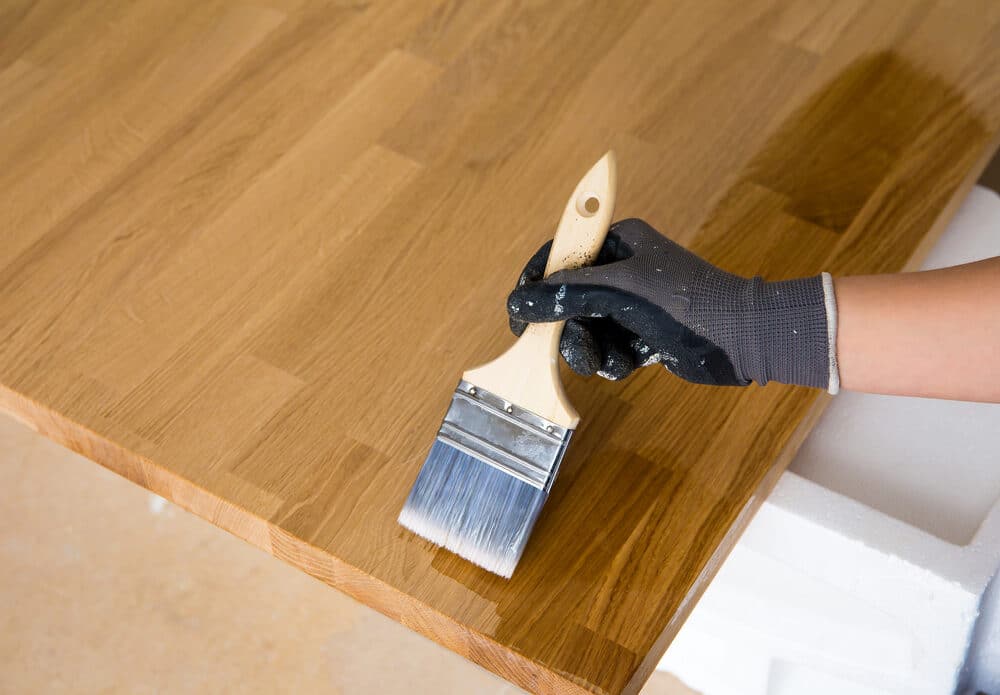
Understanding Sanding
Sanding is a fundamental process in the maintenance and restoration of kitchen worktops, and it’s essential to comprehend why it’s a crucial step in the care routine. This section will delve into the depths of sanding, shedding light on its significance and various aspects.
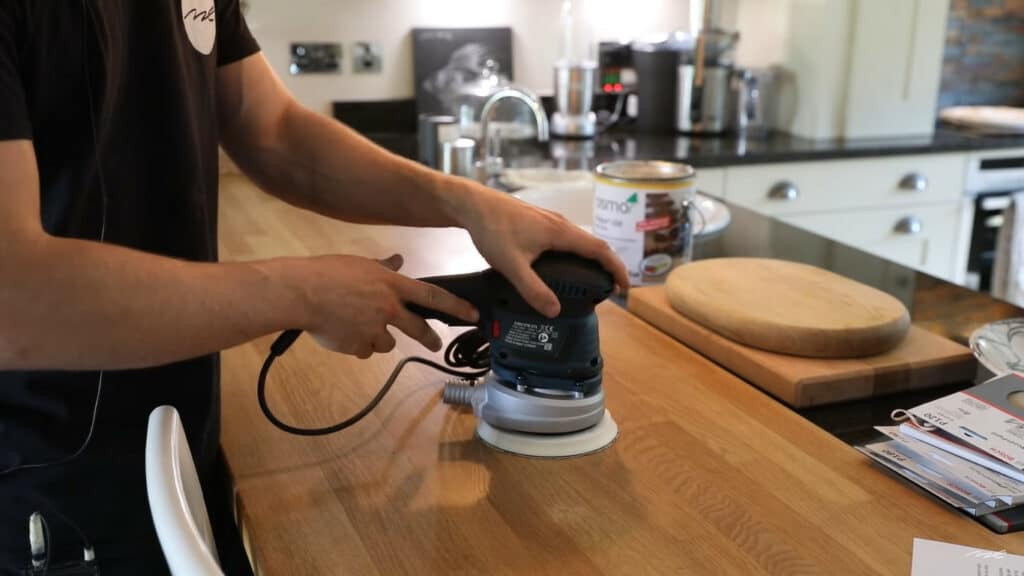
Why Sanding is Necessary for Kitchen Worktops:
- Surface Imperfections: Over time, kitchen worktops can accumulate scratches, stains, and uneven spots due to regular use. Sanding is a technique to address these imperfections and restore a smooth, flawless surface.
- Wood Grain Enhancement: For wooden worktops, sanding brings out the natural beauty of the wood grain, adding warmth and character to your kitchen.
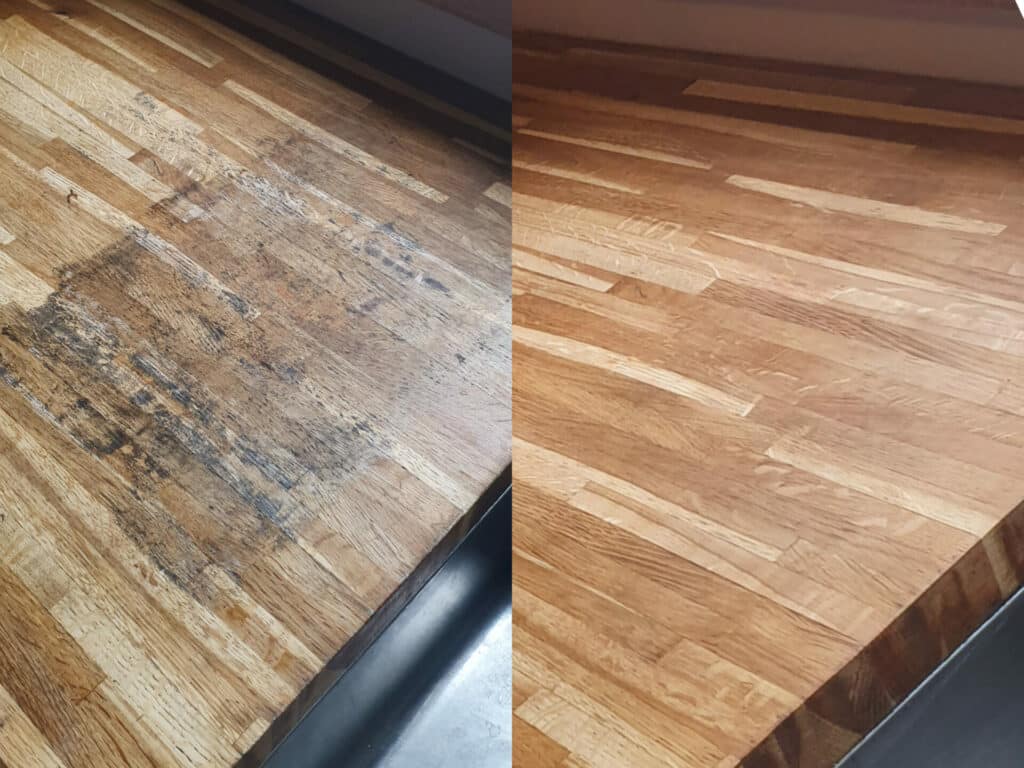
Different Sanding Methods and Their Purposes:
- Coarse to Fine: Kitchen Worktop Sanding involves the use of progressively finer grits of sandpaper to remove imperfections. Coarser grits are used for heavy-duty work, while finer grits create a smoother finish.
- Hand vs. Power Sanding: You can choose between hand sanding and using power sanders. Each method has its advantages, and the choice depends on the scale of the project and personal preference.
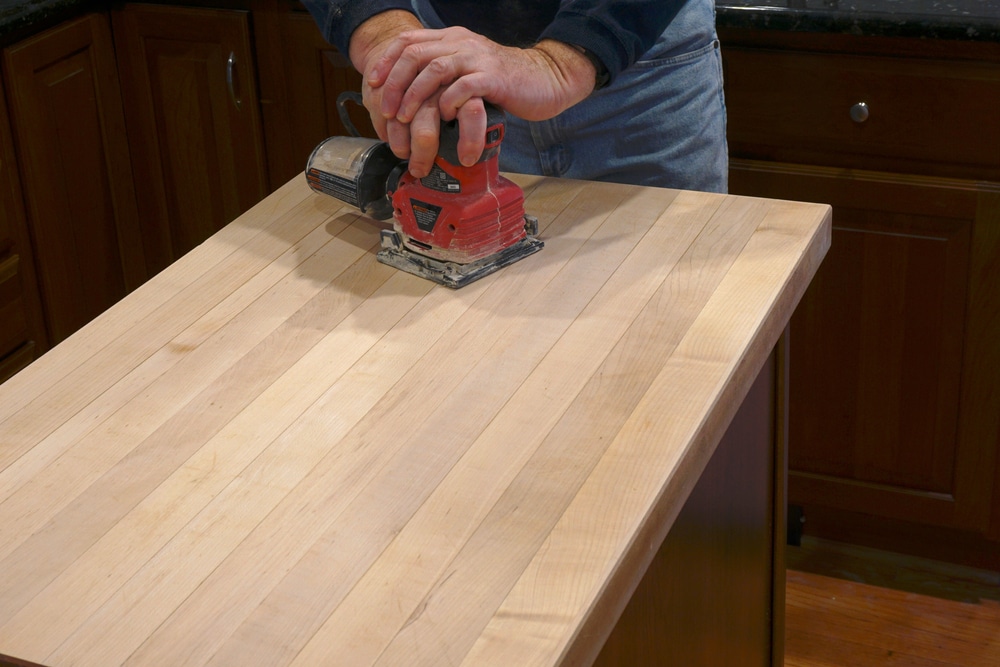
How to Prepare Your Worktop for Sanding:
- Cleaning: Before sanding, it’s crucial to thoroughly clean the worktop to remove any dirt, debris, or residues that could damage the sandpaper or affect the sanding process.
- Removing Hardware: If your worktop has any hardware, such as knobs or handles, it’s advisable to remove them to ensure even sanding.
The benefits of kitchen worktop sanding
Kitchen Worktop sanding is a transformative process for your kitchen worktop that offers a wide range of benefits beyond just cosmetic improvements. In this section, we’ll explore the significant advantages of sanding and why it should be an essential part of your worktop maintenance routine.
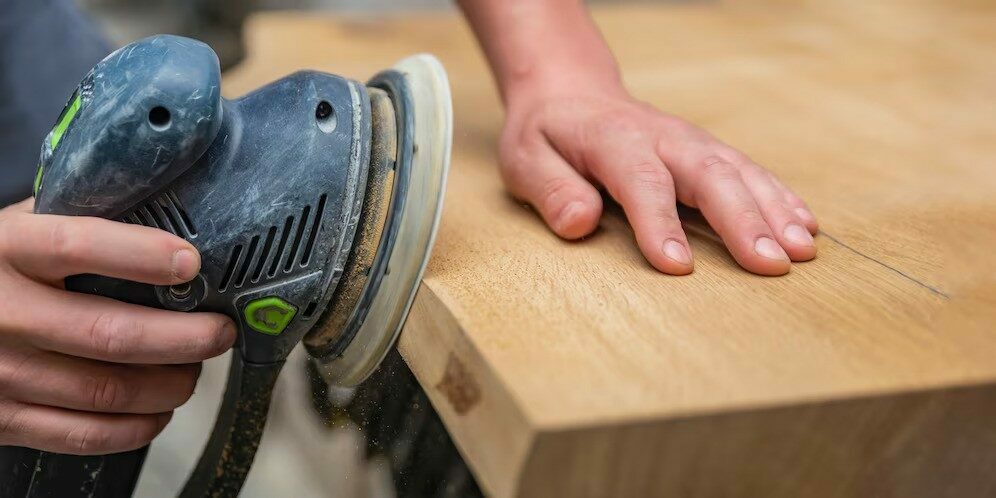
Improved Aesthetics:
- One of the most noticeable benefits of sanding is the enhancement of your worktop’s appearance. Sanding helps to remove surface imperfections such as scratches, dents, and minor stains, giving your worktop a fresh, like-new look.
- For wooden worktops, sanding also brings out the natural beauty of the wood grain. This process can reveal intricate patterns and colours that may have been hidden beneath years of wear and tear, adding warmth and character to your kitchen.
Enhanced Durability:
- Sanding plays a crucial role in extending the lifespan of your kitchen worktop. By smoothing out the surface, it reduces the impact of daily wear and tear.
- It can also prevent minor issues from escalating into more significant problems. For example, addressing small scratches and stains through sanding can prevent them from becoming deeper and harder to repair over time.
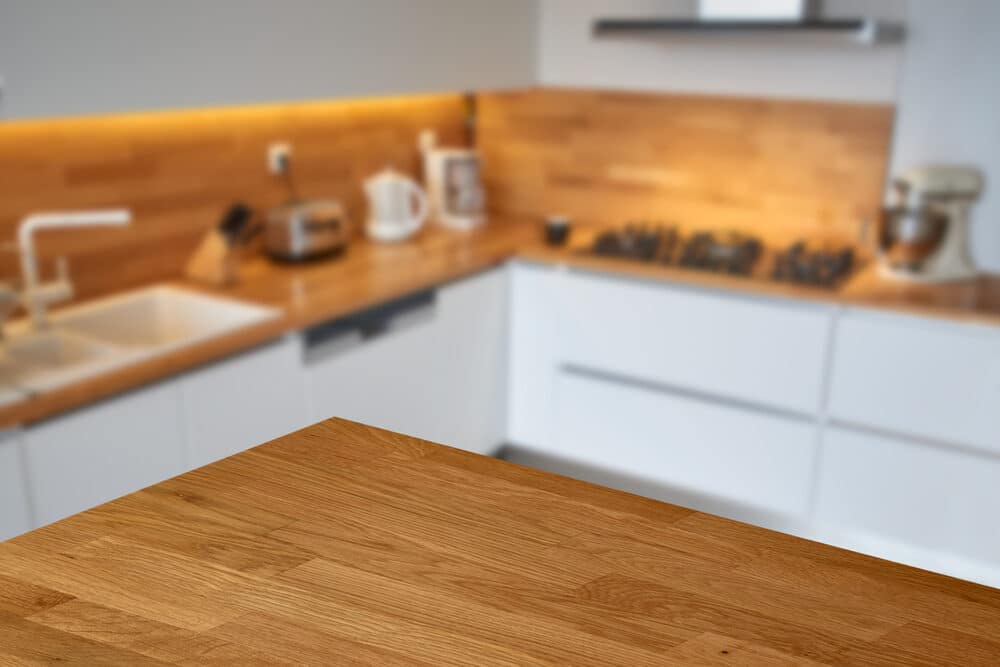
Scratch and stain removal:
- Sanding effectively eliminates or minimises the visibility of scratches, stains, and other surface blemishes. It levels out the worktop’s surface, making imperfections less conspicuous or even entirely erasing them.
- This benefit is particularly valuable for high-traffic areas like kitchen worktops, where scratches and stains are common due to the use of knives, pots, and spills.
Renewed Hygiene and Cleanliness:
- Sanding removes microorganisms, bacteria, and particles that can accumulate in scratches and grooves on the worktop’s surface. This results in a cleaner and more hygienic kitchen environment.
- A smoother worktop is also easier to clean and maintain, reducing the effort required to keep your kitchen surfaces spotless.

Cost-Effective Maintenance:
- Regular sanding is a cost-effective way to preserve the quality and longevity of your kitchen worktop. It can postpone the need for more extensive repairs or replacements, saving you money in the long run.
- Compared to the expense of replacing a damaged or worn worktop, the investment in sanding is relatively small.
When to Sand Your Kitchen Worktop
Knowing when to sand your kitchen worktop is essential for maintaining its beauty and functionality. Sanding at the right time can prevent minor issues from becoming major problems. In this section, we’ll explore the signs and situations that indicate it’s time to sand your kitchen worktop.
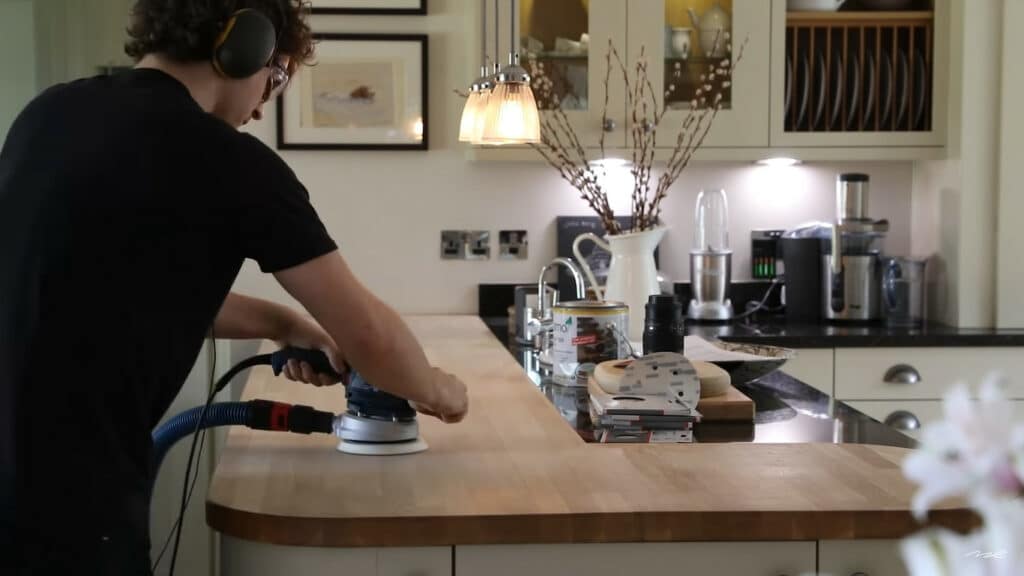
Visible Surface Imperfections:
- The most apparent sign that it’s time to sand your worktop is the presence of visible surface imperfections. These may include scratches, dents, gouges, or stains that mar the worktop’s appearance.
- If you notice these imperfections becoming more noticeable or widespread, it’s a clear indication that sanding is needed to restore the worktop’s smooth and flawless surface.
Rough or uneven texture:
- Run your hand over the worktop’s surface periodically. If it feels rough or uneven to the touch, this suggests wear and tear that can be addressed through sanding.
- Uneven textures can make cleaning and food preparation more challenging, so it’s essential to sand the worktop to regain a smooth and user-friendly surface.
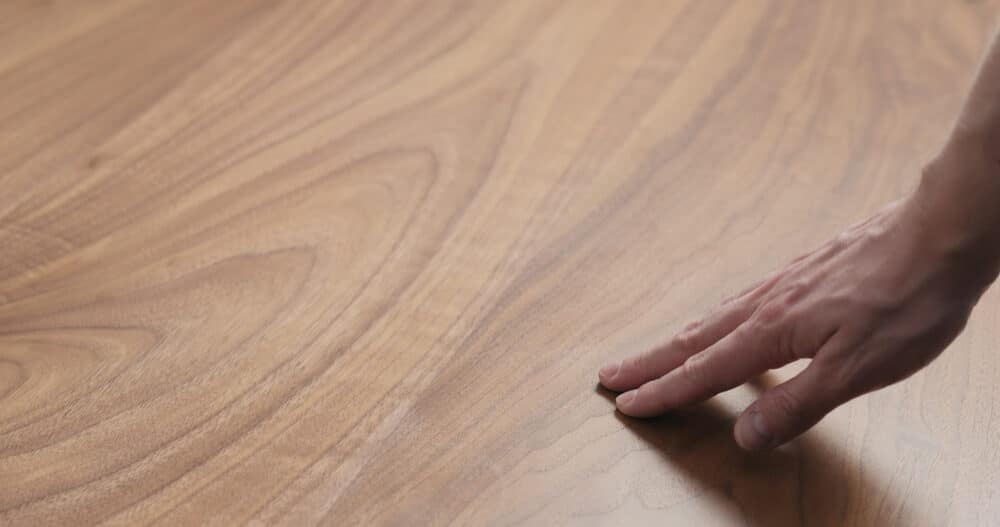
Loss of Natural Finish (for Wooden Worktops):
- Wooden worktops can lose their natural finish over time due to exposure to moisture, heat, and daily use. If the wood’s lustre has faded or the colour appears dull, sanding can help restore its original beauty.
- Additionally, if the wood appears dry or shows signs of minor cracking, sanding, followed by reoiling, can replenish its moisture and vitality.
Wear and tear around high-use areas:
- Kitchen worktops often experience more wear and tear in specific areas, such as around the sink or near the stove, where spills, moisture, and heat are frequent.
- Inspect these high-use areas regularly, and if you notice signs of wear, including discoloration or roughness, consider sanding to prevent further deterioration.
Stains That Are Difficult to Remove:
- Some stains, especially those from acidic substances or deep-set discoloration, may be challenging to remove with regular cleaning methods.
- If your worktop has stubborn stains that resist conventional cleaning, sanding may be the solution to eliminate or minimise their appearance.
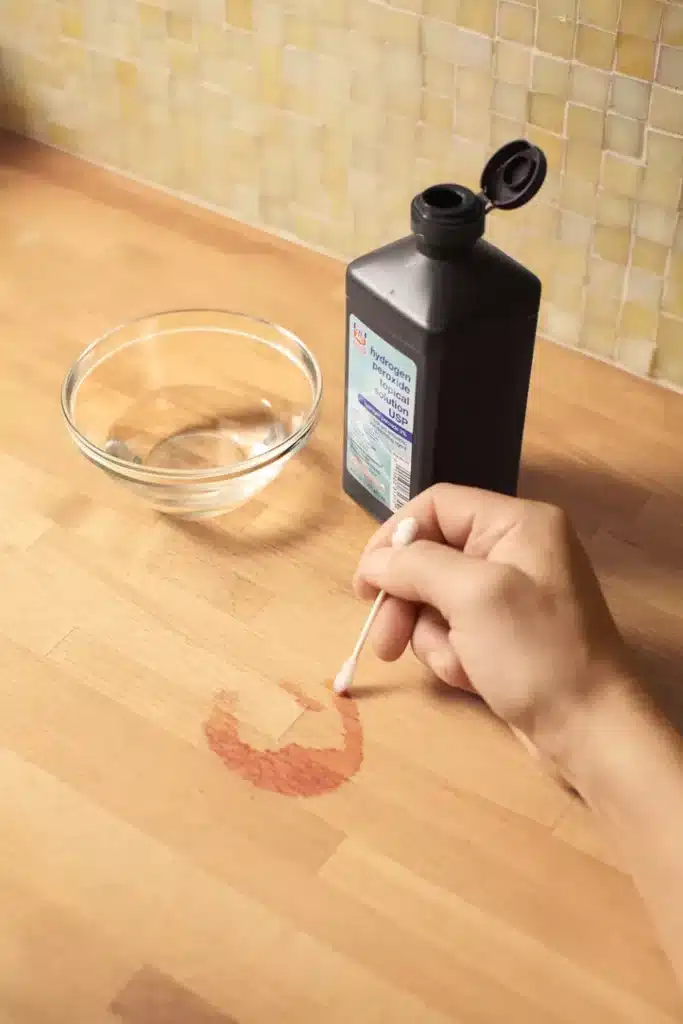
Regular Maintenance Schedule:
- Implementing a regular maintenance schedule for sanding, even if you don’t observe visible issues, can help prevent problems from developing. This proactive approach ensures that your worktop remains in top condition.

Post-Sanding Care
After successfully sanding your kitchen worktop, proper post-sanding care is crucial to maintain the results and ensure the longevity of your worktop’s new finish. This section will guide you through the essential steps and considerations for caring for your worktop after sanding.
Cleaning the Worktop Surface:
- Before proceeding with any post-sanding care, it’s essential to clean the worktop thoroughly to remove dust, debris, and sanding residue. Use a damp, lint-free cloth or a microfiber towel to wipe down the entire surface.
- Ensure that the worktop is completely dry before moving on to the next steps to prevent moisture-related issues.

Should You Reoil Your Kitchen Worktop After Sanding?
- One of the primary questions that arises after sanding is whether or not to reoil the worktop. The decision depends on the material of your worktop and your personal preferences.
- For wooden worktops, reoiling is typically recommended as it helps restore the wood’s natural moisture and protective finish. It also enhances the wood’s appearance and durability.
- For other materials like quartz or granite, reoiling is not necessary, as these materials do not benefit from oil treatments. Instead, focus on cleaning and maintaining their surfaces.
The Role of Oil in Worktop Maintenance:
- If you decide to reoil your wooden worktop, choose a high-quality, food-safe oil specifically designed for kitchen surfaces. Common options include mineral oil, walnut oil, or a specialised worktop oil.
- Applying a thin, even coat of oil to the worktop surface helps nourish the wood, protect it from moisture, and restore its sheen. Follow the manufacturer’s instructions for the specific oil you choose.
- Allow the oil to penetrate the wood for the recommended time, typically around 15–30 minutes, and then wipe off any excess oil with a clean, dry cloth.
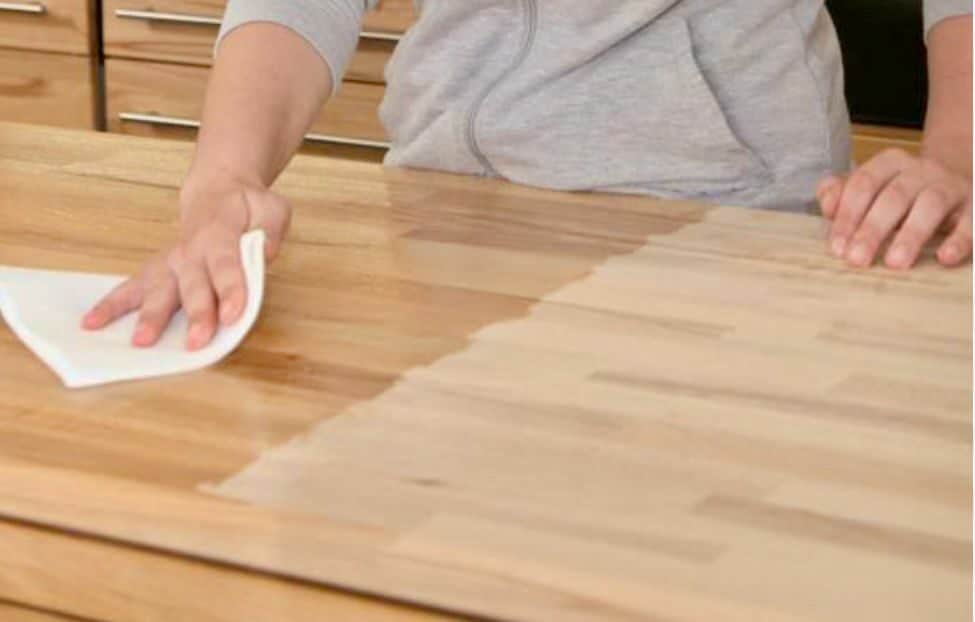
Regular Maintenance:
- To prolong the benefits of sanding and post-sanding care, establish a regular maintenance routine for your kitchen worktop. This includes daily cleaning to prevent spills and stains from setting in and periodic oiling as needed for wooden surfaces.
- Use cutting boards and hot pads to protect your worktop from direct contact with sharp knives and hot pots and pans.
Monitoring and touch-ups:
- Keep an eye on your worktop’s condition and address any new scratches, stains, or wear as they occur. Promptly addressing these issues can prevent them from becoming more significant problems.
Enjoy Your Newly Revived Worktop:
- With proper post-sanding care, your kitchen worktop will not only look refreshed but also perform at its best. Enjoy the enhanced aesthetics and functionality of your workspace.
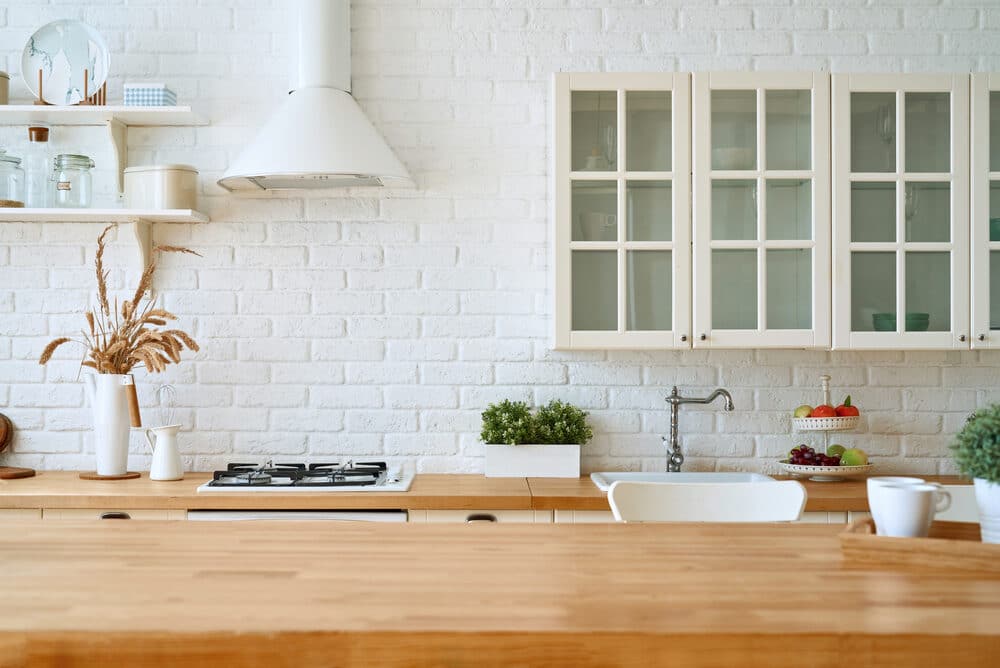
Pros and Cons of Reoiling Your Kitchen Worktop
Deciding whether to reoil your kitchen worktop after sanding is an important consideration. Reoiling can have both advantages and potential drawbacks, depending on your specific needs and preferences. In this section, we’ll explore the pros and cons to help you make an informed decision.
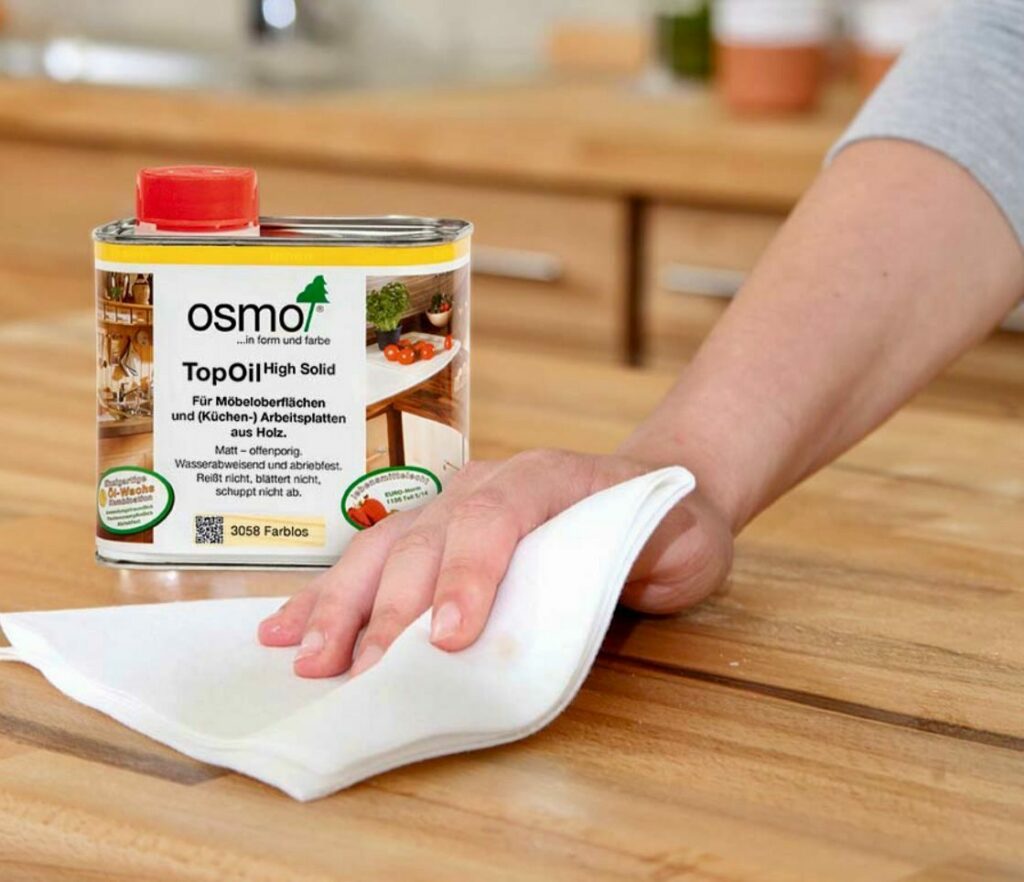
Pros of Reoiling:
- Restores and Enhances Appearance:Reoiling wooden worktops can restore and enhance their natural beauty. It brings out the wood’s grain patterns, enriches the colour, and provides a warm, inviting look to your kitchen.
- Moisture Protection: Oiling creates a protective barrier on wooden worktops, repelling moisture and preventing it from seeping into the wood. This can help prevent warping, cracking, and other moisture-related damage.
- Improved Durability: Regular oiling can extend the lifespan of your wooden worktop by minimising wear and tear. It makes the surface more resistant to scratches, stains, and daily use, enhancing its durability.
- Food-Safe Option: Many worktop oils are food-safe and do not pose health risks. This is important for kitchen surfaces where food preparation and contact are frequent.
- Easy Application: Applying oil to your worktop is a straightforward process that can be done without professional assistance. It’s a DIY-friendly maintenance step.

Cons of Reoiling:
- Requires Maintenance: Reoiling is not a one-time solution. It requires ongoing maintenance, typically every few months or as needed, to keep the worktop in optimal condition.
- Temporary Solution: While reoiling can rejuvenate your worktop’s appearance and protection, it is not a permanent solution. Over time, the effects of oiling will wear off, necessitating repeated applications.
- Potential for Oily Residue: Applying too much oil or not wiping off excess oil properly can leave a greasy residue on the worktop’s surface. This residue may attract dust and dirt.
- Incompatibility with Some Materials: Reoiling is primarily suitable for wooden worktops. It is not applicable or necessary for other materials like quartz, granite, or laminate, which have different maintenance requirements.
- Initial Odour and Drying Time: Some worktop oils may have an initial odour, which can be bothersome until it dissipates. Additionally, the oil may take time to dry completely, requiring you to avoid using the worktop temporarily.
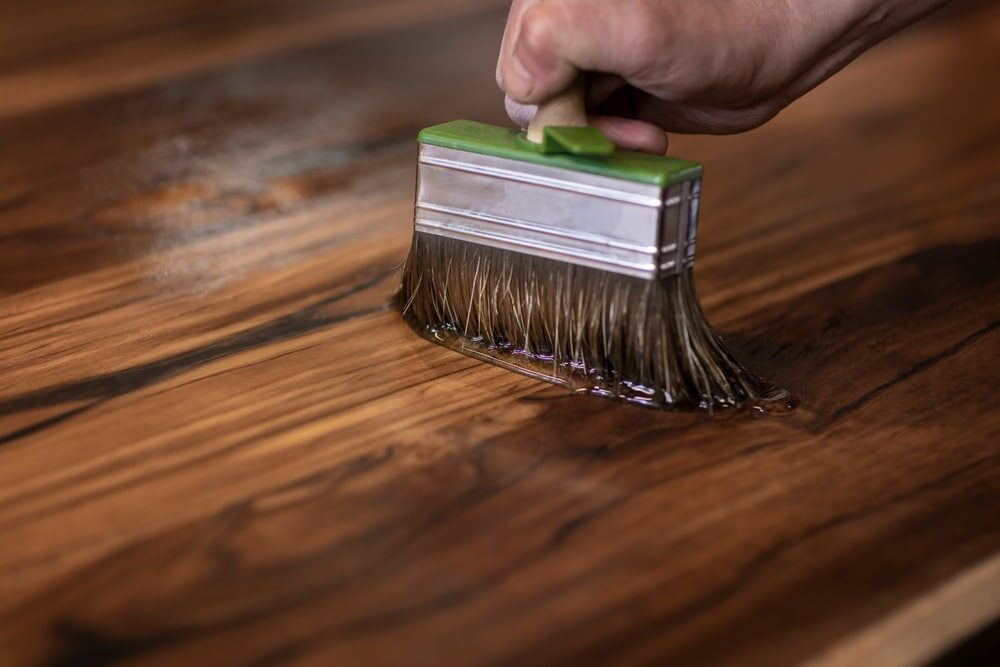
Conclusion
Maintaining your kitchen worktop is essential for preserving its beauty, functionality, and longevity. Sanding is a crucial step in this maintenance process, and whether or not to reoil your worktop after sanding is a decision that can significantly impact its overall condition. In this article, we’ve explored the various aspects of post-sanding care and the pros and cons of reoiling, providing you with valuable insights to help you make an informed choice.
Sanding your kitchen worktop offers numerous benefits, from improving aesthetics and enhancing durability to removing surface imperfections and ensuring a hygienic surface. It is a proactive approach to worktop maintenance that can extend the life of your kitchen’s centrepiece.
When it comes to reoiling, the decision largely depends on the material of your worktop and your personal preferences. For wooden worktops, reoiling is often recommended, as it restores the wood’s natural beauty, provides moisture protection, and enhances durability. However, it’s important to note that reoiling requires ongoing maintenance and may not be suitable for all worktop materials.
In the end, the key to successful post-sanding care lies in regular maintenance and proactive measures. Whether you choose to reoil your worktop or opt for alternative methods, such as cleaning and protective measures, the goal is to keep your kitchen worktop in top-notch condition. By staying attentive to its needs and addressing issues as they arise, you can enjoy a beautiful and functional worktop that serves as the heart of your kitchen for years to come.
Incorporate the knowledge and tips provided in this article into your kitchen worktop maintenance routine, and you’ll be well-equipped to make the most of your kitchen worktop, ensuring it remains a source of pride and utility in your home.

Sanding
We provide virtually dust-free sanding with our continuous belt machinery with mobile extraction units, giving you a safer environment for your family.
Oiling
This organic finish not only adds beauty to your home but also has exceptional water-repellent characteristics, making it easier to clean and maintain.
Waxing
This natural floor finish offers the softest and most mellow appearance – and leaves your floor able to breath.
Buffing
Using soft buffing machines (and hand-polishing where required) will bring a wonderful sheen to your newly-finished floor.
Repairs
We offer a full assessment of your wooden floors to determine what repairs are needed to provide the perfect working surface for the later stages of sanding, staining and sealing.
Restoration
We offer a comprehensive restoration process designed to address floors that are improperly fitted or damaged over time through wear and tear.
Request a fixed price quote for your wood floor restoration now
Simply enter your postcode below to get started.
Services
Wood Floor Sanding Wood Floor Restoration Wood Floor Scratch Repair Squeaky Wood Floor Repair Parquet Floor Sanding Parquet Floor Restoration Commercial Floor Sanding Church Floor Sanding Community Centre Floor Sanding School Floor Sanding Gap Filling Gap Filling with ResinCopyright © Mr Sander®
Privacy & Cookies Terms & Conditions Complaints Procedure Cancellation Rights Sitemap

